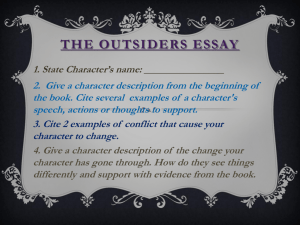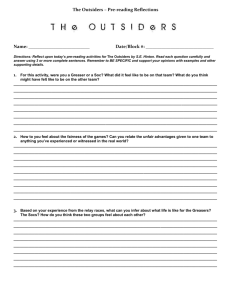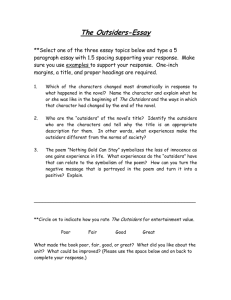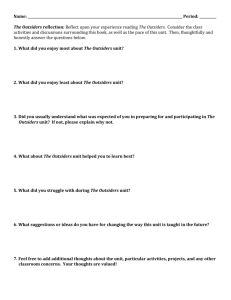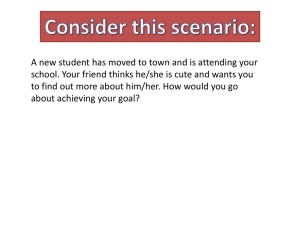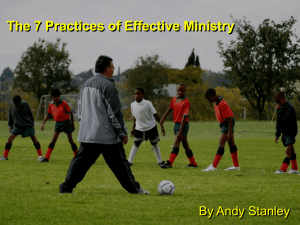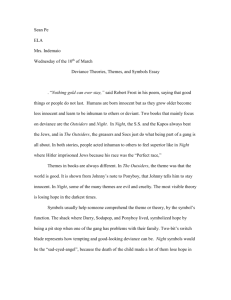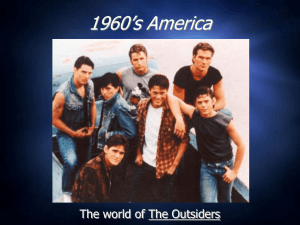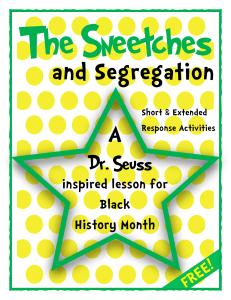The Outsiders is Still "In": Why This Old Novel Is So Popular with
advertisement
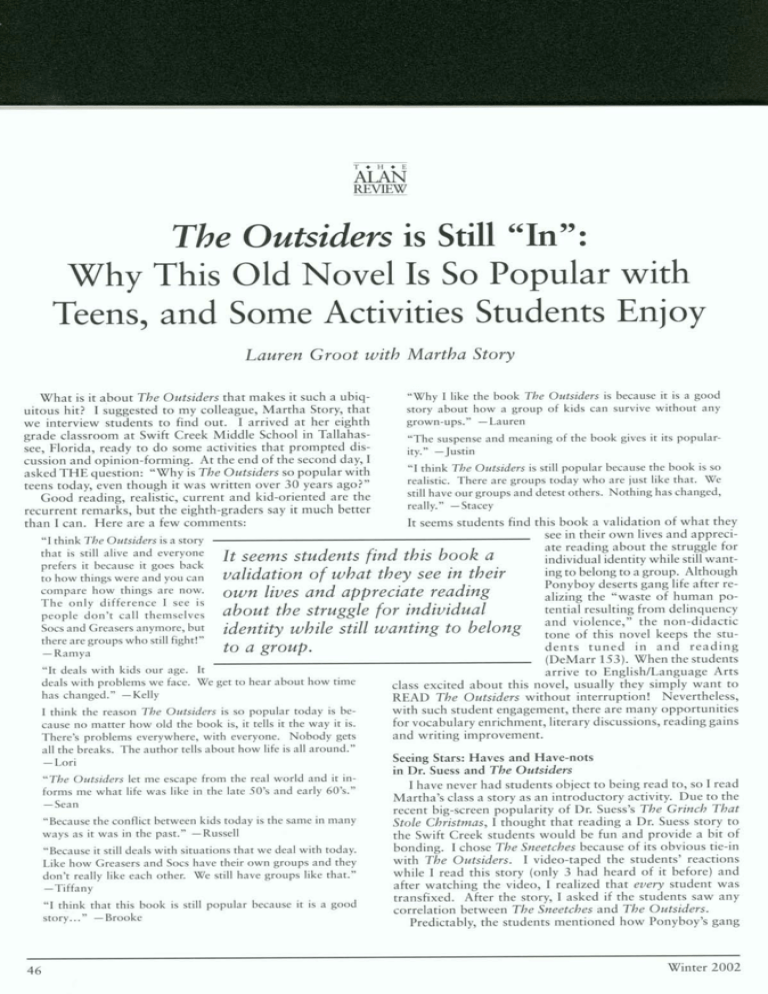
T • H • E ALAN REVIEW The Outsiders is Still "In": Why This Old Novel Is So Popular with Teens, and Some Activities Students Enjoy Lauren Groot with Martha Story What is it about The Outsiders that makes it such a ubiq­ uitous hit? I suggested to my colleague, Martha Story, that we interview students to find out. I arrived at her eighth grade classroom at Swift Creek Middle School in Tallahas­ see, Florida, ready to do some activities that prompted dis­ cussion and opinion-forming. At the end of the second day, I asked THE question: "Why is The Outsiders so popular with teens today, even though it was written over 30 years ago?" Good reading, realistic, current and kid-oriented are the recurrent remarks, but the eighth-graders say it much better than I can. Here are a few comments: "Why I like the book The Outsiders is because it is a good story about how a group of kids can survive without any grown-ups." -Lauren "The suspense and meaning of the book gives it its popular­ ity." -Justin "1 think The Outsiders is still popular because the book is so realistic. There are groups today who are just like that. We still have our groups and detest others. Nothing has changed, really." -Stacey It seems students find this book a validation of what they see in their own lives and appreci­ ate reading about the struggle for It seems students find this book a individual identity while still want­ ing to belong to a group. Although validation of what they see in their Ponyboy deserts gang life after re­ own lives and appreciate reading alizing the "waste of human po­ tential resulting from delinquency about the struggle for individual and violence," the non-didactic identity while still wanting to belong tone of this novel keeps the stu­ to a group. dents tuned in and reading (DeMarr 153). When the students "It deals with kids our age. It arrive to English/Language Arts deals with problems we face. We get to hear about how time class excited about this novel, usually they simply want to has changed." -Kelly READ The Outsiders without interruption! Nevertheless, I think the reason The Outsiders is so popular today is be­ with such student engagement, there are many opportunities cause no matter how old the book is, it tells it the way it is. for vocabulary enrichment, literary discussions, reading gains There's problems everywhere, with everyone. Nobody gets and writing improvement. all the breaks. The author tells about how life is all around." Seeing Stars: Haves and Have-nots -Lori in Dr. Suess and The Outsiders "The Outsiders let me escape from the real world and it in­ I have never had students object to being read to, so I read forms me what life was like in the late 50's and early 60's." Martha's class a story as an introductory activity. Due to the -Sean recent big-screen popularity of Dr. Suess's The Crinch That "Because the conflict between kids today is the same in many Stole Christmas, I thought that reading a Dr. Suess story to ways as it was in the past." -Russell the Swift Creek students would be fun and provide a bit of bonding. I chose The Sneetches because of its obvious tie-in "Because it still deals with situations that we deal with today. with The Outsiders. I video-taped the students' reactions Like how Greasers and Socs have their own groups and they while I read this story (only 3 had heard of it before) and don't really like each other. We still have groups like that." after watching the video, I realized that every student was - Tiffany transfixed. After the story, I asked if the students saw any "I think that this book is still popular because it is a good correlation between The Sneetches and The Outsiders. story ... " - Brooke Predictably, the students mentioned how Ponyboy's gang "I think The Outsiders is a story that is still alive and everyone prefers it because it goes back to how things were and you can compare how things are now. The only difference I see is people don't call themselves Socs and Greasers anymore, but there are groups who still fight!" -Ramya 46 Winter 2002 was like the Sneetches without stars; the Socs were like the Sneetches with stars. But the conversation took an interest­ ing turn: discussion ensued about how some people they know, as well as celebrities, "ghetto-up," referring to the fash­ ion statement and attitude that copies the look and counte­ nance of people who are from "the ghetto." Hippies, who displayed their lack of materialism through an unmanicured appearance, were mentioned in this discussion, also. Some­ times, the students said, "It's cool to be on the outside." I asked the students, "What happens when everyone is trying to be cool by being on the outside?" "That is when things change," Justin said. "Different is usually cooler. Sameness isn't." Nodding of eighth-grade heads confirmed this remark. I found this a very interesting agreement since I often wit­ ness teenagers' adherence to a "cool" code by being identical in attitude, dress and activities. During my tenure as a teacher, I have seen innumerable teens being excluded from the "in" crowd by simply dressing differently than the reigning clique. Discussions brought about by The Sneetches and The Out­ siders opened a door toward a discussion of diversity being about more than race and socio-economic status. The Herber Exercise...Using Students' Experiences to Enhance Reading Comprehension Drawing from the students' experiences in life makes for lively discussions about the vocabulary and themes in The Outsiders. On day two of my visit to Swift Creek, T intro­ duced the Herber Exercise to them, and they enthusiastically participated and competed. The Herber Exercise Step-By-Step (Simmons and Palmer) 1. Teacher identifies the next section of literature that the students are to read and writes on sentence that captures the main idea of this section. Teacher then chooses two words from this statement that students should learn and explore. 2. Students form groups of no more than four people. The group has one blank piece of paper, and the identified scribe/reporter draws a line down the middle. Reporters write one of the "main idea" words chosen by the teacher at the upper left hand corner of the paper. 3. For a specified number of minutes (four minutes works well), the groups tell their reporter the words that are pop­ ping into their head (no dictionary/thesaurus) in relation to the word from the main idea statement. When the des­ ignated time is over, the groups count their words and the teacher records the groups' results on the board. The group that comes up with the most words wins for word number one. 4. For the second word from the main idea statement, do the same as in #3, above. 5. Once the number of words are recorded for word number two, the groups take turns explaining any word-relation­ ships between the two columns. 6. Students agree or disagree with teacher-written predictive statements, related to the text that is to be read. The teacher may ask students to orally explain their opinion. See examples below under Step Six. 7. After the identified text is read, students discuss the words and predictive statements again to allow them to revisit their thoughts and opinions. The ALAN Review The Herber Exercise Applied to The Outsiders Step One: The class was to begin chapter 7 of The Outsiders the day after my visit, so my main idea statement (step 1) was drawn from that chapter: Ponyboy realizes the bleak future of vio­ lence between gangs, and that individuals, not gangs, are what is important in forming relationships. "Bleak" was a words within chapter 7, and I thought "individual" warranted some discussion. Step Two/Three/Four: The groups (of four students each) came up with an aver­ age of 20 words for both "bleak" and "individual." I would like to note that the video captured a phenomenal, atypical happening in this middle school classroom: All students were participating and engaged; everyone seemed to be having fun. The students were out of their chairs leaning around the group's elected "reporter" as they came up with words; the video validates that all students had words to share. Here is an example from ].B., Justin, John and Casey's group (spell­ ing errors excluded): Bkak dreary somber gloomy dark lonely sad depressed weak stress helpless low vulnerable cold raw bearing dismal cheerless dejection bare blank windswept Indiyidual lonesome independent Sel f-con fident single strong separate willing powerful one indivisible particular smart spiritual exclusive odd unitary special expressed difference exclusive entity sole unIque Step Five: Matches drawn between the words were explained by the group: "Lonely and single, because sometimes people who are single get lonely. Weak and one, because if you're just one, you could be weak. And bare and independent, because people are left out in the open, ya know, bare, when they're independent and don't care what people think about them." Step Six: As if on cue, I could tell the students appreciated shifting from "group work" to an individual, "no pressure" activity of simply applying their opinion to the predictive statements. They obviously enjoyed placing their no-penalty "A" or "D" for Agree/Disagree on their paper I handed them. 47 Predictive Statements (related to Chapter 7, The Outsiders) we would have a Greaser dress-up day. We brought in pic­ tures of Greaser-like attire and discussed that no knives, ciga­ 1. "Funning around" in a serious situation makes everyone rettes, etc. (real or pretend) could be brought onto campus. feel better. Most of the eighth graders in the school dressed up and 2. Chocolate cake is a nutritious breakfast. completed their look with greased-back hair or pony-tails. 3. Underprivileged people think that everyone else is better The boys rolled up their sleeves and flexed their muscles while off than themselves. the girls painted on bright red lipstick. It seems they began 4. If children were burning inside a house, anyone would run to understand the irony of these "tuff" characters: that much inside and save them. of the "tuffness" was superficial; it was a shield to ward off 5. Ponyboy and Sodapop should go to a foster home where anything that might hurt them. grown-ups more responsible than Darry could take care The movie The Outsiders, from the 1980's, was a tremen­ of them. dous hit with these modern eighth-graders. They enjoyed 6. Dallas only risked his life by going into the fire because knowing that S. E. Hinton was the nurse that came into Pony boy and Johnny needed help. Dallas's room, and they recognized some of the stars that are The predictive statements I wrote created discussion that still popular and prevalent in today's movies. Chocolate cake was animated, silly, as well as serious. At times, the conver­ and eggs, served with grape jelly were movie-time snacks sation was loud, and not a onebrought in by the parents, or pre­ at-a-time discussion, but I let pared in Teen Challenges (Home them continue and did not During my tenure as a teacher, I have Economics) class to further en­ "shush" them; ALL of the dis­ seen uncountable teens be excluded hance students' ability to make cussion was about the topic at connections with The Outsiders. from the "in" crowd by simply hand. They eventually quieted This high-interest novel, written down and took turns again. I dressing differently than the reigning near the middle of our previous was excited to see their enthu­ century, has a hook into our teens siasm. Sometimes you just clique. Discussions brought about that allows for many more teach­ have to say your opinion to by The Sneetches and The Outsiders ing opportunities. In my opinion, your neighbor and not wait to opened a door toward a discussion of remembering that students are not be called on, especially when blank slates, that they are people diversity being about more than race full of opinions, experiences and you are 13. I was surprised to find that and socio-economic status. knowledge is one of the first steps 15 of the 24 students agreed in helping students become read ­ with the first statement. All ers. Responsible, critical, and but 2 disagreed with statement number 2, and statement num­ "pleasure" readers are what we hope for, and The Outsiders ber 3 shifted the jokes about chocolate cake to serious con­ is just the novel to prompt students to join the reading "gang." versation about how people perceive themselves and others. Works Cited Statement 4 was equally split, and the students who believed it amoral to not save the burning children accepted the other DeMarr, Mary Jean & Jane S. Bakerman. The Adolescent in students' rationale that risking one's own life could ultimately the American Novel Since 1960. Ungar: New York, 1986. be a "stupid move." All of the students believed that Darry Simmons, John S. & Barbara C. Palmer. Reading By Doing: was the right person to be raising Pony boy and Sodapop; An Introduction to Effective Reading. National Textbook and all of the students thought Dallas only went into the fire Company: Illinois, 1995. 254-264. to help Johnny and Pony boy. Dress Up and Go to the Movies As fashion is so important to teens, much discussion cen­ tered around what the teenagers in The Outsiders wore. Martha brought in a madras shirt one day; the students loved this visual, as it answered some of their questions about style in this novel. Martha and I decided that since the students were espe­ cially interested in the fashion preferences of the Greasers, 48 Lauren Groot is a former teacher of Spanish and language arts at Swift Creek Middle School, Tallahassee, Florida. She is currently on the English faculty at Bainbridge College, Bainbridge, Georgia. Martha Story, currently a teacher of English at Lawton Chiles High School in Tallahassee, Florida, has taught language arts at Swift Creek Middle School and music at Kate Sullivan Elementary School, both also in Tallahassee. Winter 2002
